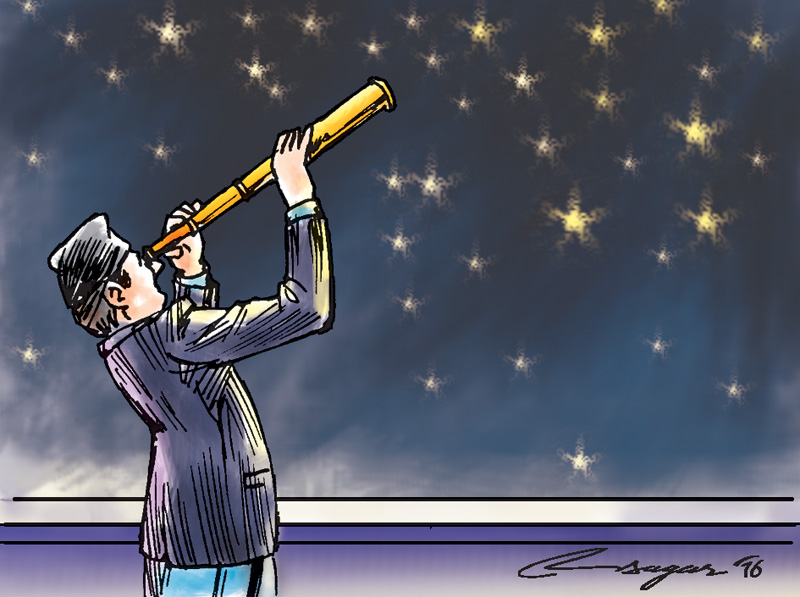Losing darkness: light pollution
From any urban or suburban area in Nepal, the night sky is not clearly visible because of the sky glow from various sources of artificial lights from buildings, advertisement boards, neon lights and factories
Our lives have always been enriched with the songs, poems, stories and a myriad of other compositions which depict the beauty and charm of the countless marvelous stars of the night sky.
Be it in the form of a lullaby for children or an awe-inspiring story that exists as a folk cultural tale first told by our ancestors hundreds of years ago, we certainly have a deep and intimate connection with the stars out there.
But when we only had fire to light the world, this intimacy with the stars existed at a more personal level. Our ancestors gazed up into the night sky as they slept under the canopy of the seemingly infinite stars and created stories like that of the Pleiades with the help of our biological genius for pattern recognition.
Undoubtedly, it pushed writers, poets, and storytellers to work and scientists to ponder about our existence and our locational coordinates in the cosmos. The stars also lit the way for us to understand where and who we are in the cosmos.
But sadly, if you happen to live in an urban area, the nights are no longer dark and the stars are no longer visible because of a seemingly harmless yet evidently detrimental process of Light Pollution.
Light Pollution (photo pollution or luminous pollution) is simply the excessive, unwanted and disproportionate emission of artificial light towards the sky which undoubtedly results in the brightening of the night sky.
Light is vital to living organisms like us; we humans are dependent on it for Vitamin D and the plants require it for photosynthesis.
While this type of pollution seems harmless to us at first because of the vitality of light, Light Pollution has been shown to have startling adverse effects not only in astronomical observations and human health but also in the breeding and migrating habitats of various organisms and disruption in ecosystems.
It started very innocuously with the discovery of fire and later with the invention of the electric bulb in the 1870s. But even in this revolutionary era of science and technology, Light Pollution is subtly affecting all walks and all types of life on Earth.
Because of Light Pollution, even the wilderness is illuminated. Strangely, we are losing our darkness at the speed of light.
If you’ve ever tried searching for stars in the night sky from an urban or suburban area, you’ll notice that you are able to find only a few of them that are the brightest of all or the closest to Earth.
Only a century ago, the night sky was much darker. That can explain why people come to know about what the Milky Way galaxy looks like only when the light sources go off unexpectedly.
Very often, Light Pollution is jokingly articulated as ‘the bane of the astronomers’ as it limits their observation of various celestial objects. It can have profound effects on all of us humans, despite our professions whatsoever.
It can thus justly be concluded that Light Pollution has caused various problems in the ecosystem by misdirecting organisms towards artificial habitats.
We humans are no exception to the list of the living organisms affected by Light Pollution as it affects our circadian rhythm which is embedded in our biological makeup. Circadian rhythm refers to the physical, mental and behavioral changes that occurs in an organism in a 24-hour cycle.
For 3.8 billion years, life on Earth has evolved and adjusted itself with the regularity of the sunrises and the sunsets crafting its own natural biological clock.
A group of nerve cells, Suprachiasmatic Nucleus (SCN) located above the optic nerve secretes Melatonin hormone when there’s less incoming light. Melatonin makes us drowsy and ready to sleep which is vital for the restoration of energy.
But, Light Pollution disturbs the secretion of this hormone ultimately leading to insomnia and other sleep disorders along with obesity, depression and seasonal affective disorders.
Artificial light has been recognized as a carcinogen that causes various types of cancer like Breast and Prostate Cancer too. Drivers and pedestrians temporarily blinded by glare have met with tragic accidents as well.
Many might argue about the relevance of this article for Nepal. After all Nepal has lesser urban areas and lesser technological advancements than countries like the USA or that of Europe.
Even more crucially, it still suffers from an absolute problem of load shedding, so it is pertinent to raise the question. But from any urban or suburban area in Nepal, the night sky is not clearly visible because of the sky glow from various sources of artificial lights from buildings, advertisement boards, neon lights, factories, and, domestic and international airports that remain unaffected by the load shedding schedule in the country.
We must also consider the fact about where we stand in terms of Light Pollution in the World and also have a clear concept about how pollution-free our light sources are.
While Light Pollution may seem to be moderate for Nepal in an average, trends of intensifying Light Pollution in the industrial-urban areas can be marked easily.
One can discern these trends using the Blue Marble Navigator, night-lights imagery by NASA Earth Observatory. This indicates that Nepal’s urbanization is not scientific; not Light Pollution free.
Now that we have to make a sustainable choice; whether to invest huge sums of money to ‘cure’ Light Pollution afterwards or to make simple changes in our urbanization patterns that’ll ‘prevent’ Light Pollution itself in the first place.






